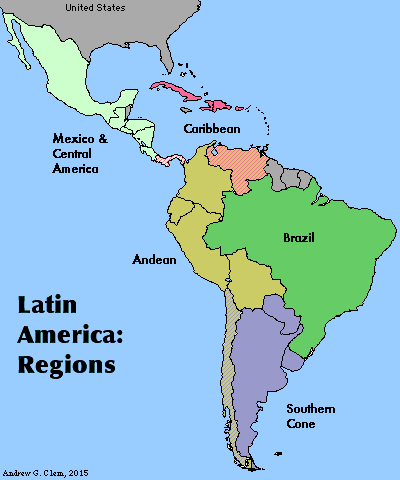



Home page >> Latin America Introduction Last updated:
~ Latin America blog ~
General info pagesCountry pages |
Latin American election cycles
For the first round presidential election each country, the most recent year is shown. |
|||||||||||||||||||||||||
| . |  Argentina 5 (May) |
 Bolivia 4 (Aug. 6) |
 Brazil 4 (Jan.) |
 Chile (4) (Jan.) |
 Colombia 5 (July) |
 Ecuador 4 () |
 Paraguay 5 (Aug. 15) |
 Peru 5 (July 28) |
 Uruguay 5 (Mar.) |
 Venezuela 5 (!?) |
|---|---|---|---|---|---|---|---|---|---|---|
| 2024 | Javier Milei | Luis A. Arce | "Lula" da Silva | Gabriel Boric | Gustavo Petro | Daniel Noboa | Santiago Peña | Dina Boluarte | Lacalle Pou | Maduro // |
| . |  Costa Rica |
 Cuba |
 Dominican Rep. |
 El Salvador |
 Guatemala |
 Haiti |
 Honduras |
 Mexico |
 Nicaragua |
 Panama |
| 2023 | (Rodrigo) Chaves | Diaz-Canel | Abinader | Bukele | Giammattei | (P.M. Ariel Henry) | Castro | Lopez Obrador | Ortega | Cortizo |
| KEY | . | military | left wing | moderate left | centrist / undefined | authoritarian populist |
moderate right | right wing | . | . |
This information is extracted from the Presidents page, which shows a chronology going back to 1980.
The twenty nations of Latin America can be grouped, more or less, into five subregional groups, based on geography and cultural affinity. There is some "overlap" among these subregions, however: Venezuela, Panama, and Chile combine aspects of two subregions, while Costa Rica and Paraguay are each rather distinctive in their own right. Since I have greater expertise in the Andean region, I tend to pay more attention to those countries.
 Before independence from Spain, the Viceroyalty of New Spain (as Mexico was called) extended through all of Central America with the exception of Panama. Most of the countries in this region bear significant residual influence from the Mayan Indian civilization, which began to decline centuries before Columbus arrived. For the first two decades after independence (1821-1838, roughly), there was a unified Central American Confederation. This broke apart into five countries, however, and this region remained backwards for many decades thereafter.
Before independence from Spain, the Viceroyalty of New Spain (as Mexico was called) extended through all of Central America with the exception of Panama. Most of the countries in this region bear significant residual influence from the Mayan Indian civilization, which began to decline centuries before Columbus arrived. For the first two decades after independence (1821-1838, roughly), there was a unified Central American Confederation. This broke apart into five countries, however, and this region remained backwards for many decades thereafter.
The island nations of the Caribbean embody a great variety of cultural influences, reflecting the four European nations that colonized them: Spain, France, Britain, and the Netherlands. A high proportion of people are descended from African slaves.
Geographically, this region is united by the mountainous terrain plus the cultural legacy of the Inca Empire. Most of these countries were liberated by Simon Bolivar, who dreamed of creating a vast confederation of Spanish-speaking countries. Although there is a semi-effective regional institution (the Andean Group), lingering jealousy and ancient animosity between the neighbors have prevented the goal of regional political-economic integration from being carried out.
Brazil is nearly as big as the United States in terms of land area, and is by far the most populous country in Latin America, so size alone qualifies it as a separate region. The fact that it is the only Portuguese- speaking country in the Western Hemisphere makes it stand out even more. The country has a vibrant, fun-loving culture, with much more relaxed social norms than in Spanish America, where the Catholic Church tends to have a stronger influence.
In terms of both ethnicity and dialect, this southernmost part of Latin America does live up to its claim to be the "most European" part of the region. A large proportion of the population in Argentina and Uruguay are of Italian descent, while Germans and Basques make up a substantial portion of the Chilean population. Ironically, despite all the economic advantages and relative lack of ethnic friction that affects the Andean countries, Mexico, and Central America, the Southern Cone has never lived up to its promise. Quite the contrary, some of the most barbaric violence anywhere in Latin America took place in Chile and Argentina during the "Dirty War" of the 1970s and 1980s.
Thomas E. Skidmore, Peter H. Smith, and James N. Green, Modern Latin America 8th ed. (Oxford, 2014)
Howard J. Wiarda and Harvey F. Kline, Latin American Politics and Development 5th ed. (Westview, 2000)
Scott Mainwaring and Timothy R. Scully, Building Democratic Institutions: Party Systems in Latin America (Stanford, 1995)
Jan Knippers Black (ed.), Latin America: Its Problems and Its Promise 2nd ed. (Westview Press, 1991)
Lawrence E. Harrison, The Pan-American Dream: Do Latin America's Cultural Values Discourage True Partnership with the United States and Canada? (Boulder: Westview Press, 1997)